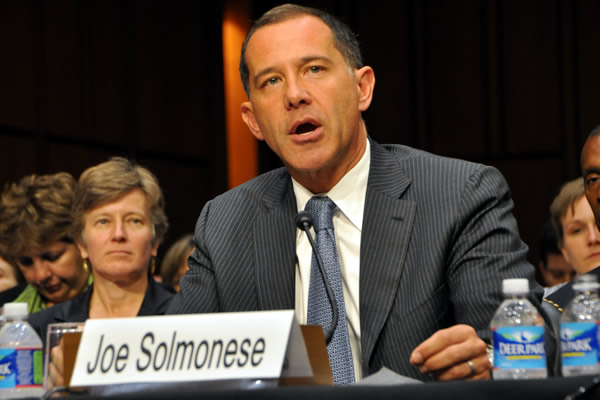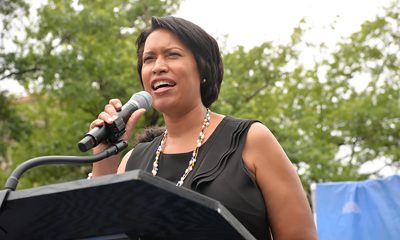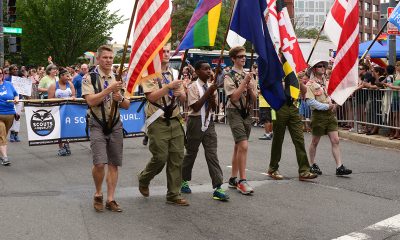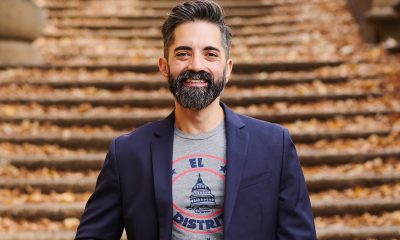National
Solmonese to step down as head of HRC
Source denies reports of sweeping shakeup
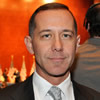
Joe Solmonese, who has served for more than six years as president of the Human Rights Campaign, the nation’s largest LGBT civil rights advocacy group, will step down from his job when his current contract ends on March 30, 2012, HRC officials announced last week. The news of Solmonese’s departure was first reported by Pam’s House Blend.
In a statement released Aug. 27, co-chairs of the board of directors of HRC and its sister organization, the HRC Foundation, said Solmonese will remain as head of both organizations “until the completion of his contract to ensure a smooth leadership transition.”
They also announced the formation of a search committee for Solmonese’s replacement to be co-chaired by board members Joni Madison of North Carolina and Dana Perlman of Los Angeles.
“Joe Solmonese is an outstanding leader,” said Anne Fay, who co-chairs the HRC Foundation board. “While we will miss his extraordinary leadership, we enter this next phase, thanks to Joe, in the best place the organization has ever been. Not only has our community secured historic victories, but our membership is larger and more active than any time in our history, and our financial health is secure even in these difficult economic times.”
HRC spokesperson Michael Cole-Schwartz said the combined revenue for HRC and the HRC Foundation for the fiscal year ending March 31, 2011 was $39.8 million. He said the two groups have about 150 employees.
Sources familiar with HRC have speculated that several LGBT movement leaders would likely emerge as candidates for Solmonese’s replacement, including Chuck Wolfe, executive director of the Gay and Lesbian Victory Fund; Brian Ellner, an HRC consultant who coordinated HRC’s efforts to help pass New York’s same-sex marriage law; Chad Griffin, head of the California-based organization that initiated the lawsuit to overturn Proposition 8; and Sean Maloney, one of former President Bill Clinton’s openly gay White House aides who later worked for former New York Gov. David Paterson.
Solmonese has received mixed reviews by LGBT activists during his tenure as head of HRC, which began in 2005. Disagreements over his and HRC’s policies and activities appear to reflect divisions within the LGBT movement.
Supporters and others familiar with the group say Solmonese has worked well in navigating HRC and its LGBT rights agenda during a hostile Bush administration and during a supportive Obama administration, using behind-the-scenes political skills to prod allies in Congress and the White House to move its agenda forward.
Critics say he and HRC have been too closely aligned with the Democratic Party and Democratic congressional leaders, which they say have failed to adequately advance LGBT legislation, such as the Employment Non-Discrimination Act (ENDA) and LGBT-supportive immigration legislation while Democrats controlled the House of Representatives.
The statement released by the HRC board co-chairs says that under Solmonese’s leadership, HRC expanded its public outreach programs, including the start of its Healthcare Equality Index, which, among other things, assesses the sensitivity of hospitals in caring for LGBT people.
HRC and the HRC foundation launched or expanded other important programs during Solmonese’s tenure, the board statement says, in the area of outreach to religion and faith communities, schools programs promoting fair treatment of LGBT youth, and a family and children initiative to open adoption agencies to LGBT parents.
In the area of legislation, the board statement said Solmonese played a key role in steering HRC’s opposition to the Federal Marriage Amendment, a proposed constitutional ban on same-sex marriage. They also note that under his tenure, Congress passed a hate crimes law with protections for LGBT people and repealed the “Don’t Ask, Don’t Tell” law barring gays from serving openly in the military.
The statement notes that during his tenure, the Obama administration put in place a number of administrative directives and policy changes favorable to LGBT people, including a policy banning discrimination against federal government workers based on gender identity.
Dana Beyer, executive director of the transgender advocacy group Gender Rights Maryland and a former HRC board member, said Solmonese alienated many in the transgender community and in the LGBT community in general in 2007 when he declined to oppose a decision by House Democratic leaders to remove protections for transgender people from ENDA.
Then Speaker of the House Nancy Pelosi (D-Calif.), a longtime supporter of LGBT rights, and Rep. Barney Frank (D-Mass.), who’s gay, said they determined at the time that ENDA couldn’t pass in the House if a transgender provision remained in the bill. The House passed a so-called “gay only” version of the bill that year over strong objections from a coalition of dozens of LGBT groups from across the country. Pelosi and Frank said they would introduce a separate bill with transgender protections at a later date, when support for such a bill could be lined up.
Solmonese said it would have put HRC in an untenable position to oppose a major gay rights bill backed by longtime LGBT rights supporters in the House. The bill died when the Senate did not bring it up for a vote.
Solmonese and HRC changed their position on the bill the following year, saying the organization would no longer support ENDA without a provision protecting transgender people from job discrimination.
But Beyer and other LGBT activists said HRC’s earlier position left deep scars within the transgender community, which felt abandoned by HRC.
Others have said the LGBT movement as a whole was divided over HRC’s position, with many in the movement – including D.C.’s Gay and Lesbian Activists Alliance and the Gertrude Stein Democratic Club – supporting an incremental approach of passing a sexual orientation-only version of ENDA while continuing to push hard for adding a transgender provision as soon as possible.
Those holding that view said they favored a fully inclusive ENDA but recognized such a bill could not pass at the time.
Beyer said that in addition to the ENDA flap, many LGBT activists believe HRC is devoting too much of its resources to marriage equality, including the repeal of the Defense of Marriage Act, at the expense of other legislation, such as a trans-inclusive ENDA. Beyer argues that ENDA would help many more LGBT people than those interested in getting married.
“Many of us are hoping HRC will change its direction on some of these issues under a new president,” she said. “But the president is really nothing more than a reflection of the board of directors,” she said. “If the board of directors doesn’t want to change the direction of the organization, it doesn’t matter who the next president is.”
Richard Socarides, president of the national LGBT advocacy group Equality Matters, said Solmonese has performed well in advancing the LGBT agenda.
“He has been there when some very important gains took place,” he said. “And I think he did a tremendous job building the organization.”
Socarides said he disagrees with some critics who say HRC failed to do enough to push ENDA or is placing too much emphasis on marriage equality.
“I don’t think they can be blamed for the failure to pass any particular piece of legislation just as they can’t take all the credit for the legislation that has passed,” he said.
“But what I have said before is that as an organization, they have not sufficiently leveraged their power to bring about change more quickly,” Socarides said. “They are a key part of the Washington establishment but they seem to seek change within existing structures. They are very reluctant to rock the boat.”
Rick Rosendall, vice president of D.C.’s Gay and Lesbian Activists Alliance, and Bob Summersgill, GLAA’s former president, each said HRC under Solmonese’s leadership has provided strong support for the efforts by D.C. activists in passing a same-sex marriage law. The two said Solmonese also arranged for HRC to devote considerable resources to fight efforts by members of Congress to attach anti-gay riders to the city’s annual appropriations bill. Congress must approve the city’s annual budget under the city’s limited home rule charter.
Summersgill and Rosendall noted that HRC, among other things, helped to line up support to defeat proposals by Republican lawmakers to ban same-sex couples from adopting children in the city.
Lateefah Williams, president of the Gertrude Stein Democratic Club, said she, too, appreciated Solmonese’s support for D.C.’s marriage equality campaign, noting that he directed HRC to provide a full-time field organizer to help local activists build support in the community for the same-sex marriage bill.
Williams said she also shares the views of some that HRC should broaden its support for transgender rights initiatives as well as efforts to support programs aimed at minorities within the LGBT community, such as blacks and Latinos, and youth.
“I wish Joe well,” she said.
News of Solmonese’s departure was first reported by the blog Pam’s House Blend last week. The blog cited unnamed sources as saying his departure may be part of a sweeping staff shakeup initiated by the HRC board and that news of his leaving came about under less than amicable circumstances.
Other sources familiar with HRC told the Blade that account was inaccurate. One source familiar with the group characterized as “complete fiction” claims of a staff shakeup as well as claims by some that HRC may already have lined up a successor for Solmonese.
“This is about as normal and straight forward as it gets,” said the source. “He’s giving them six months advance notice. They’re going to launch a replacement process. The organization will go through that and come out with a successor.”
In a letter to HRC volunteers across the country, Solmonese discussed the timing of his decision to leave the group.
“While there may never be an ideal time, this moment seems right for me and my family,” he said. “In addition to our unprecedented victories, the health and future of the Human Rights Campaign has never been more robust,” he said. “My successor will lead a thriving organization despite the recent economic challenges.”
California
LGBTQ community calls out Radio Korea over host’s homophobic comments
Station acknowledged controversy, but skirted accountability
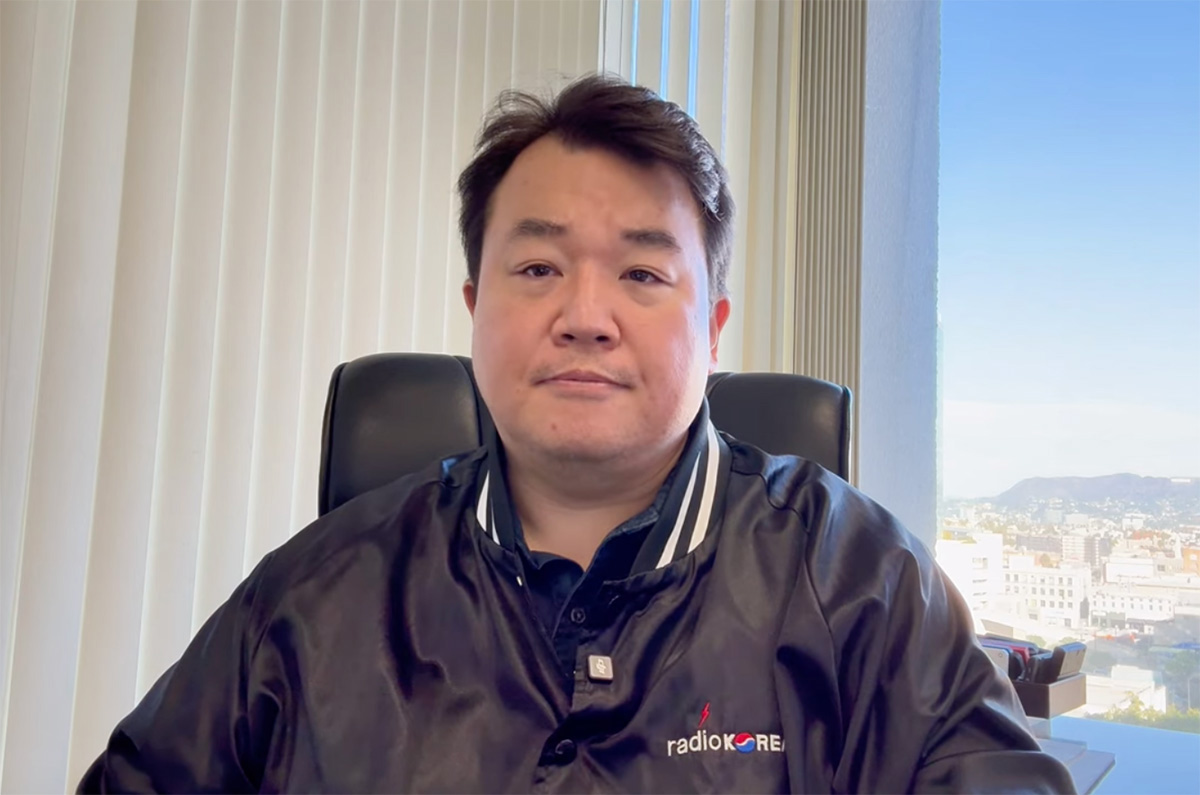
On Monday, Nov. 3, Radio Korea aired its regular morning talk show program, where one of its hosts, Julie An, discussed her lack of support for the LGBTQ community, citing her religious beliefs. She also went on to comment that gay people spread HIV and AIDS, and that conversation therapy — which has been linked to PTSD, suicidality, and depression — is a viable practice. Clips of this have since been taken down.
Radio Korea offers Korean language programming to engage local Korean American and Korean immigrant community members. Its reach is broad, as Los Angeles is home to the largest Korean population in the U.S, with over 300,000 residents. As An’s words echoed through the station’s airwaves, queer Korean community members took to social media to voice their concern, hurt, and anger.
In a now-deleted Instagram post, attorney, activist, and former congressional candidate David Yung Ho Kim demanded accountability from the station. Writer and entertainer Nathan Ramos-Park made videos calling out Radio Korea and An, stating that her comments “embolden” people with misinformation, which has the ability to perpetuate “violence against queer people.”
Community health professional Gavin Kwon also worries about how comments like An’s increase stigma within the Korean immigrant community, which could lead to increased discrimination against queer people and their willingness to seek health care.
Kwon, who works at a local clinic in Koreatown, told the Los Angeles Blade that comments like An’s prescribe being gay or queer as a “moral failure,” and that this commonly-held belief within the Korean immigrant community, particularly in older generations, strengthens the reticence and avoidance clients hold onto when asked about their gender or sexual orientation.
“When you stigmatize a group, people don’t avoid the disease — they avoid care,” Kwon explained. “They avoid getting tested, avoid disclosing their status, and avoid talking openly with providers. Stigma pushes people into silence, and silence is the worst possible environment for managing any infectious disease.”
For weeks, Radio Korea did not offer a direct response to the public criticism. Its Instagram feed continued to be updated with shorts, featuring clips of its various hosts — including An.
On Friday, Radio Korea CEO Michael Kim released an official statement on the station’s YouTube page. In this video, Michael Kim stated that An’s comments “included factual inaccuracies” and that the station “does not endorse or share the personal opinions expressed by individual hosts.” Michael Kim also stated that Radio Korea “welcomes members of the LGBT community to share their perspectives” in order to deepen understanding through dialogue.
Afterwards, Michael Kim continued that though he acknowledges the “pain” felt by queer community members, he concluded: “I don’t think Radio Korea needs to apologize for what was said any more than Netflix should apologize for what Dave Chappelle says, or any more than Instagram or TikTok should apologize for what people say on their platforms.”
Michael then offered a justification that An’s statements were “not part of a news report,” and that he was “disappointed” that David Yung Ho Kim, specifically, had been vocal about An’s comments. Michael Kim stated that he was the first person to interview David Yung Ho Kim in 2020 during his congressional campaign, and that he had provided the candidate a platform and opportunity to educate listeners about politics.
“After all these years, the support Radio Korea has given him,” said Kim, “the support I personally gave him, even the support from other Radio Korea members who donated or even volunteered for him — he dishonestly tried to portray Radio Korea as being an anti-gay organization.”
Michael Kim went on to criticize David Yung Ho Kim’s purported “hurry to condemn others,” and also questioned if David has disowned his father, who he states is a pastor. “What kind of person is David Kim, and is this the kind of person we want in Congress?” Michael Kim asked viewers, noting that Koreatown is “only about three miles from Hollywood, and some people just like to perform.”
At the end of the video, Michael Kim stated that his duty is to guard the legacy of the station. “My responsibility is to protect what was built before me and ensure that Radio Korea continues serving this community long after today’s momentary controversies disappear,” he said.
For community members and advocates, this response was unsatisfactory. “The overall tone of the statement felt more defensive than accountable,” Kwon wrote to the Blade. “Instead of a sincere apology to the LGBTQ+ community that was harmed, the message shifts into personal grievances, political dynamics, and side explanations that don’t belong in an official response.”
Michael Kim’s portrayal of the criticism and calls to action by community members as a “momentary controversy” paints a clearer picture of the station’s stance — that the hurt felt and expressed by its queer community members is something that will simply pass until it is forgotten. An continues to be platformed at Radio Korea, and was posted on the station’s social media channels as recently as yesterday. The station has not outlined any other action since Michael Kim’s statement.
U.S. Military/Pentagon
Pentagon moves to break with Boy Scouts over LGBTQ and gender inclusion
Leaked memo shows Hegseth rejecting Scouting America’s shift toward broader inclusion
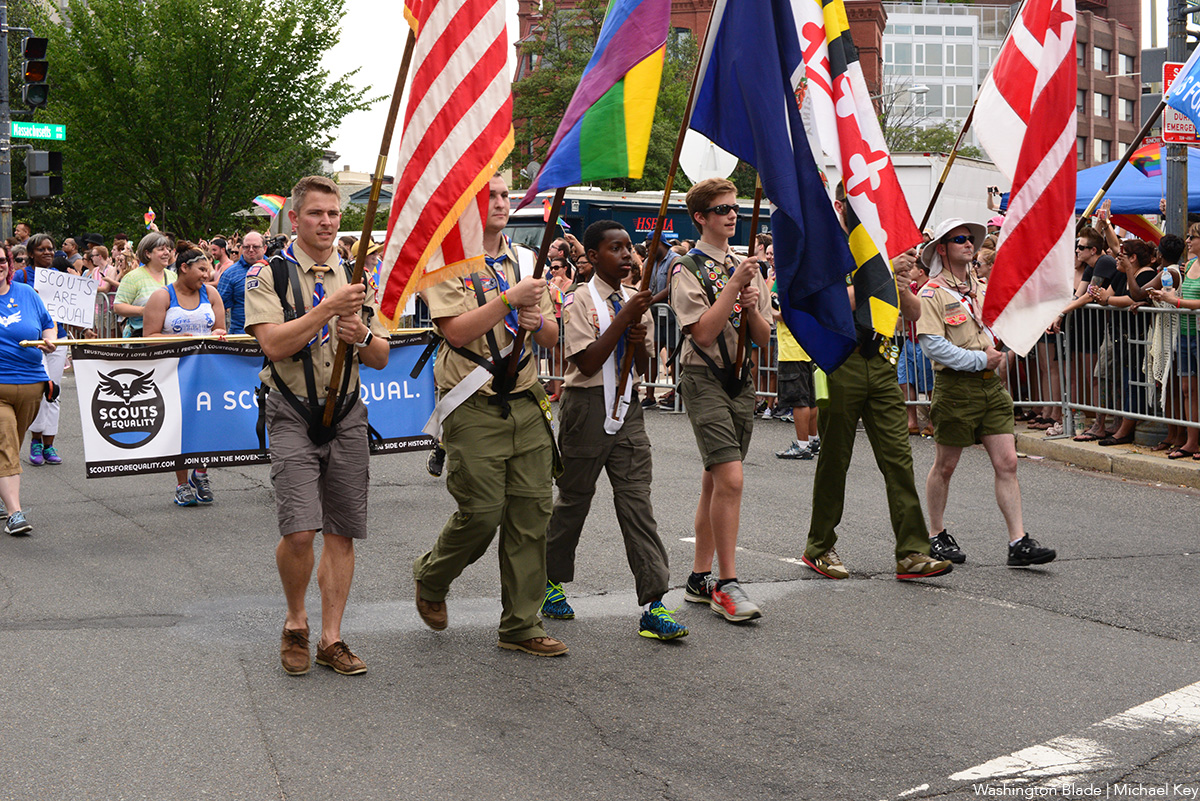
The Pentagon is preparing to sever its longstanding partnership with the Boy Scouts of America, now known as Scouting America.
In a draft memo to Congress obtained by NPR, Defense Secretary Pete Hegseth criticizes the organization for being “genderless” and for promoting diversity, equity, and inclusion.
“The organization once endorsed by President Theodore Roosevelt no longer supports the future of American boys,” Hegseth wrote, according to Defense Department sources.
Girls have been eligible to join Cub Scouts (grades K–5) since 2018, and since 2019 they have been able to join Scouts BSA troops and earn the organization’s highest rank of Eagle Scout.
A statement on the Scouting America website says the shift toward including girls stemmed from “an expanding demand to join the Boy Scouts” and a commitment to inclusivity. “Throughout the late 20th and early 21st centuries, it has undergone significant changes to become more inclusive of the adult staff and volunteers that drive its programming as well as of scouts and their families,” the organization says.
Part of that broader push included lifting its ban on openly gay members in 2014 and on openly gay adult leaders in 2015.
Once the Pentagon finalizes the break, the U.S. military will no longer provide medical and logistical support to the National Jamboree, the massive annual gathering of scouts in West Virginia that typically draws about 20,000 participants. The memo also states that the military will no longer allow scout troops to meet on U.S. or overseas installations, where many bases host active scout programs.
Hegseth’s memo outlines several justifications for the decision, arguing that Scouting America has strayed from its original mission to “cultivate masculine values” by fostering “gender confusion.” It also cites global conflicts and tightening defense budgets, claiming that deploying troops, doctors and vehicles to a 10-day youth event would “harm national security” by diverting resources from border operations and homeland defense.
“Scouting America has undergone a significant transformation,” the memo states. “It is no longer a meritocracy which holds its members accountable to meet high standards.”
The Pentagon declined NPR’s request for comment. A “War Department official” told the outlet that the memo was a “leaked document that we cannot authenticate and that may be pre-decisional.”
The leaked memo comes roughly one month after nearly every major journalism organization walked out of the Pentagon in protest of new rules requiring reporters to publish only “official” documents released by the department — effectively banning the use of leaked or unpublished materials.
President Donald Trump, who serves as the honorary head of Scouting America by virtue of his office, praised the Jamboree audience during his 2017 visit to West Virginia. “The United States has no better citizens than its Boy Scouts. No better,” he said, noting that 10 members of his Cabinet were former Scouts.
Hegseth was never a scout. He has said he grew up in a church-based youth group focused on memorizing Bible verses. As a Fox News host last year, he criticized the Scouts for changing their name and admitting girls.
“The Boy Scouts has been cratering itself for quite some time,” Hegseth said. “This is an institution the left didn’t control. They didn’t want to improve it. They wanted to destroy it or dilute it into something that stood for nothing.”
NBC News first reported in April that the Pentagon was considering ending the partnership, citing sources familiar with the discussions. In a statement to NBC at the time, Pentagon spokesman Sean Parnell said, “Secretary Hegseth and his Public Affairs team thoroughly review partnerships and engagements to ensure they align with the President’s agenda and advance our mission.”
The Scouting America organization has has long played a role in military recruiting. According to numbers provided by Scouting America, many as 20 percent of cadets and midshipmen at the various service academies are Eagle Scouts. Enlistees who have earned the Eagle rank also receive advanced entry-level rank and higher pay — a practice that would end under the proposed changes.
The White House
Trans workers take White House to court over bathroom policy
Federal lawsuit filed Thursday

Democracy Forward and the American Civil Liberties Union, two organizations focused on protecting Americans’ constitutional rights, filed a class-action lawsuit Thursday in federal court challenging the Trump-Vance administration’s bathroom ban policies.
The lawsuit, filed on behalf of LeAnne Withrow, a civilian employee of the Illinois National Guard, challenges the administration’s policy prohibiting transgender and intersex federal employees from using restrooms aligned with their gender. The policy claims that allowing trans people in bathrooms would “deprive [women assigned female at birth] of their dignity, safety, and well-being.”
The lawsuit responds to the executive order titled “Defending Women from Gender Ideology Extremism and Restoring Biological Truth to the Federal Government,” signed by President Donald Trump on his first day in office. It alleges that the order and its implementation violate Title VII of the Civil Rights Act of 1964, which prohibits sex discrimination in employment. In 2020, the U.S. Supreme Court ruled 6-3 that Title VII protects trans workers from discrimination based on sex.
Since its issuance, the executive order has faced widespread backlash from constitutional rights and LGBTQ advocacy groups for discriminating against trans and intersex people.
The lawsuit asserts that Withrow, along with numerous other trans and intersex federal employees, is forced to choose between performing her duties and being allowed to use the restroom safely.
“There is no credible evidence that allowing transgender people access to restrooms aligning with their gender identity jeopardizes the safety or privacy of non-transgender users,” the lawsuit states, directly challenging claims of safety risks.
Withrow detailed the daily impact of the policy in her statement included in the lawsuit.
“I want to help soldiers, families, veterans — and then I want to go home at the end of the day. At some point in between, I will probably need to use the bathroom,” she said.
The filing notes that Withrow takes extreme measures to avoid using the restroom, which the Cleveland Clinic reports most people need to use anywhere from 1–15 times per day depending on hydration.
“Ms. Withrow almost never eats breakfast, rarely eats lunch, and drinks less than the equivalent of one 17 oz. bottle of water at work on most days.”
In addition to withholding food and water, the policy subjects her to ongoing stress and fear:
“Ms. Withrow would feel unsafe, humiliated, and degraded using a men’s restroom … Individuals seeing her enter the men’s restroom might try to prevent her from doing so or physically harm her,” the lawsuit states. “The actions of defendants have caused Ms. Withrow to suffer physical and emotional distress and have limited her ability to effectively perform her job.”
“No one should have to choose between their career in service and their own dignity,” Withrow added. “I bring respect and honor to the work I do to support military families, and I hope the court will restore dignity to transgender people like me who serve this country every day.”
Withrow is a lead Military and Family Readiness Specialist and civilian employee of the Illinois National Guard. Previously, she served as a staff sergeant and has received multiple commendations, including the Illinois National Guard Abraham Lincoln Medal of Freedom.
The lawsuit cites the American Medical Association, the largest national association of physicians, which has stated that policies excluding trans individuals from facilities consistent with their gender identity have harmful effects on health, safety, and well-being.
“Policies excluding transgender individuals from facilities consistent with their gender identity have detrimental effects on the health, safety and well-being of those individuals,” the lawsuit states on page 32.
Advocates have condemned the policy since its signing in January and continue to push back against the administration. Leaders from ACLU-D.C., ACLU of Illinois, and Democracy Forward all provided comments on the lawsuit and the ongoing fight for trans rights.
“We cannot let the Trump administration target transgender people in the federal government or in public life,” said ACLU-D.C. Senior Staff Attorney Michael Perloff. “An executive order micromanaging which bathroom civil servants use is discrimination, plain and simple, and must be stopped.”
“It is absurd that in her home state of Illinois, LeAnne can use any other restroom consistent with her gender — other than the ones controlled by the federal government,” said Michelle Garcia, deputy legal director at the ACLU of Illinois. “The Trump administration’s reckless policies are discriminatory and must be reversed.”
“This policy is hateful bigotry aimed at denying hardworking federal employees their basic dignity simply because they are transgender,” said Kaitlyn Golden, senior counsel at Democracy Forward. “It is only because of brave individuals like LeAnne that we can push back against this injustice. Democracy Forward is honored to work with our partners in this case and is eager to defeat this insidious effort to discriminate against transgender federal workers.”
-

 District of Columbia18 hours ago
District of Columbia18 hours agoBowser announces she will not seek fourth term as mayor
-

 U.S. Military/Pentagon1 day ago
U.S. Military/Pentagon1 day agoPentagon moves to break with Boy Scouts over LGBTQ and gender inclusion
-

 Drag2 days ago
Drag2 days agoPattie Gonia calls out Hegseth’s anti-LGBTQ policies — while doing better pull-ups
-

 District of Columbia2 days ago
District of Columbia2 days agoSecond gay candidate announces run for Ward 1 D.C. Council seat

